As you can imagine, wheels are an essential component of a bike.
Not only do bike wheels allow us to roll smoothly while cycling, but they also provide dampening from lumps and bumps as well as providing traction to the surface we’re riding.
Many cyclists don’t understand how to measure a bicycle wheel, or how to measure a bike tire so I put together this bicycle wheel size guide to help you determine your current wheel size and what size bike tires you need for your wheels.
Riding with wheels that are too big or small can cause damage to your bike, so pay attention to the steps below, and you won’t have any issues!
Ready to learn how to measure a bike wheel? Let’s hit the road.
Add a header to begin generating the table of contents
Based on how much time you want to allocate to measuring your bike wheel, you can take a few different approaches.
You could attempt first to contact the manufacturer or the shop where you purchased your bike. Retailers and manufacturers have a record of all measurements and sizing information.
But be warned, retailers can be a nightmare to get hold of and often take a long time to reply.
If you have a bike tire on your wheel, you can generally find required measurement information on the tire wall (side of tire – see picture below).
Tire walls usually display the size as determined by the European Tire and Rim Technical Organization, or ETRTO and will look something like the picture below.
Bike tire wall size pictureIf you can’t find the sizing on the wall of your tire, don’t panic. Below you’ll find several methods to help you understand how to measure your bike wheel.
Alongside understanding more about your bicycle’s rim, a few of the methods below will also help you determine which tire size your wheel needs.
These steps are beneficial in those cases where you do not have a bike tire or have custom wheels, as the measurements you seek may not be readily available to you.
Typically there are two main approaches for how to measure bicycle wheel size.
Just before we begin, if your wheel doesn’t have a tire fitted, click here to move on to the next step.
The quickest way to determine your bike wheel size is the standard method.
The standard method measures the tire width and tire diameter in inches.
Let’s start with a step by step guide on completing the standard method of bike wheel measuring:
Bike Wheel RadiusBike Tire Width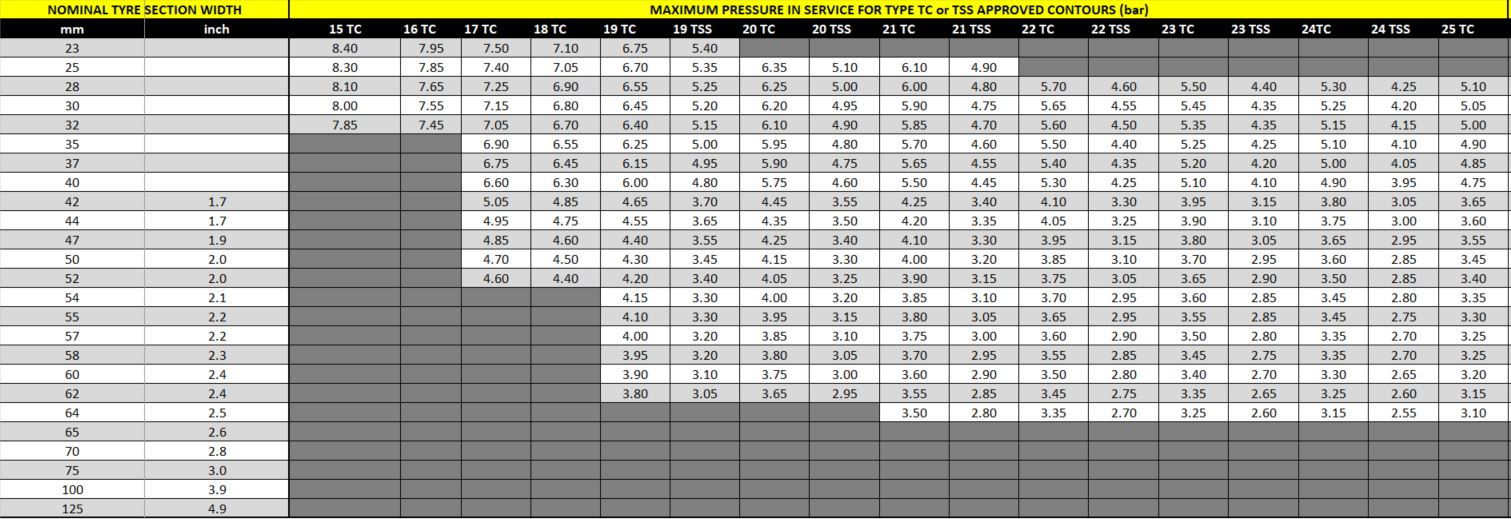
The most accurate way to measure bike tire size is through the ISO method.
ISO stands for the International Organization for Standardization, a measuring system that uses millimetres to gain the most accurate sizing possible for a bike tire.
Using this method, one measures the width of the tire and the inner diameter, or bead seat diameter.
Towards the end of the article, you’ll find a chart allowing you to compare the different ISO wheel sizes and what types of bike or vehicle each size of wheel is used with. Click here to view the chart.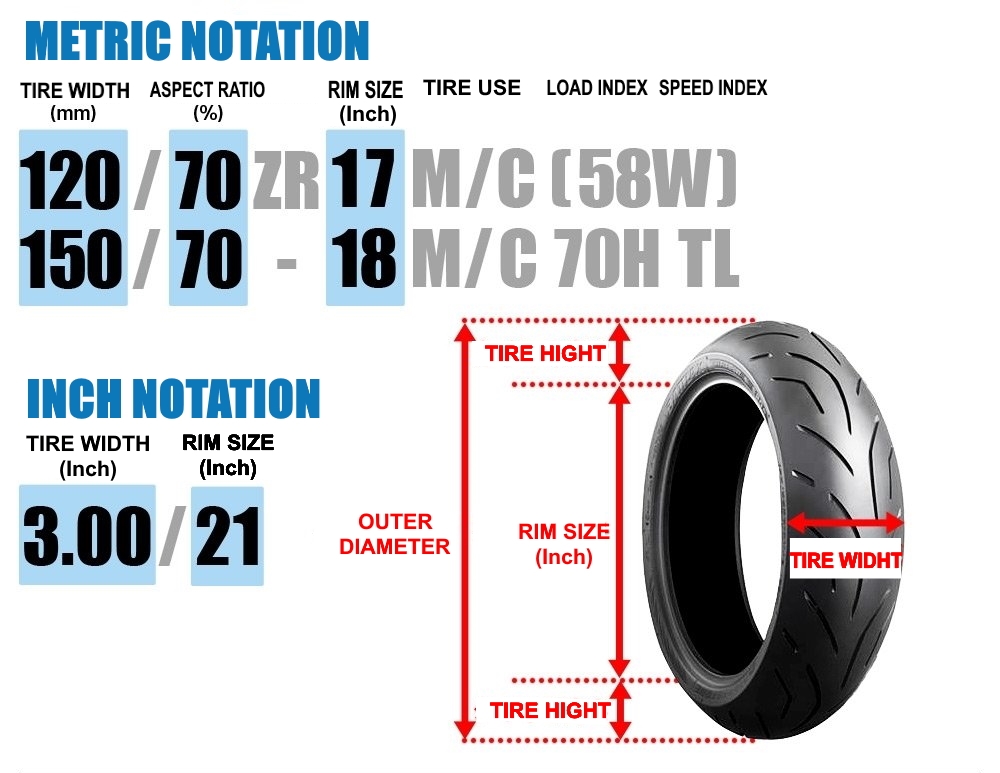
Here is a step by step guide on how to measure a bike tire using the ISO standardization method.

If you do not have your bike’s tire to hand, you can determine the tire size by measuring your bike’s rim width in millimetres as well.
Based on the average tire and wheel combinations currently on the market, the following charts illustrate the coinciding tire size and rim length.
This bike wheel has an ISO 622mm with an internal bead seat width of 15mm. Not all wheels will display their measurments!Many rims will display their size somewhere, but some rims may be missing this measurement.
If you cant find. measurement on your wheel’s rim, follow the easy steps below that will help you determine the appropriate tire sizes your rim can handle.
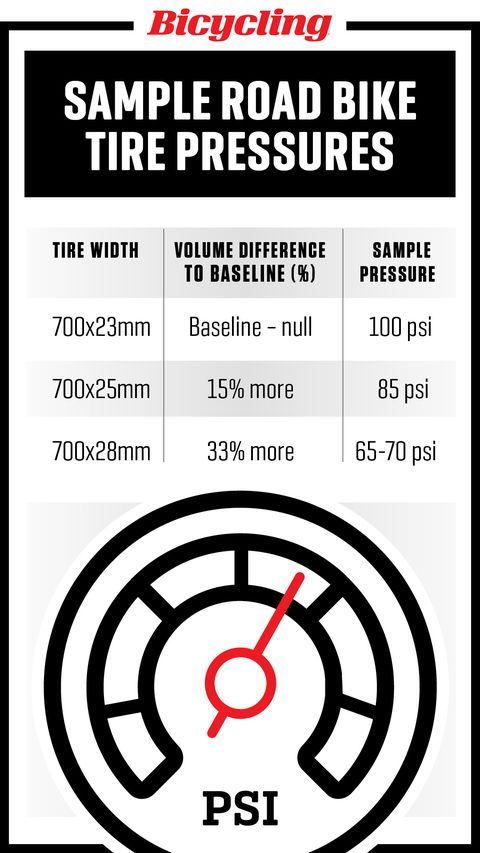
It’s important to note that these charts are based on average measurements; therefore, if possible it’s a good idea to double-check with your wheel’s manufacturer or retailer to confirm all compatible tire sizes.
It’s also important to consider the tire clearance on your fork and rear triangle. If you choose a tire that’s too wide you can end up damaging your frame and a tire that’s too thin can easily cause damage to your rim and inner tube.
| Tire Size Compatibility | Internal Rim Width |
|---|---|
| 23 - 25c | 13-15, 17-19mm |
| 25 - 28c | 13-15, 17-19, 20-21, 22-23mm |
| 30 - 33c | 17-19, 20-21, 22-23, 24-25mm |
| 33 - 35c | 17-19, 20-21, 22-23, 24-25mm |
| 38 - 40c | 20-21, 22-23, 24-25mm |
| 40 - 43c | 20-21, 22-23, 24-25mm |
| 43 - 45c | 22-23, 24-25mm |
| 45 - 48c | 22-23, 24-25mm |
| 48 - 50c | 24-25mm |
| Tire Size Compatibility | Internal Rim Width |
|---|---|
1.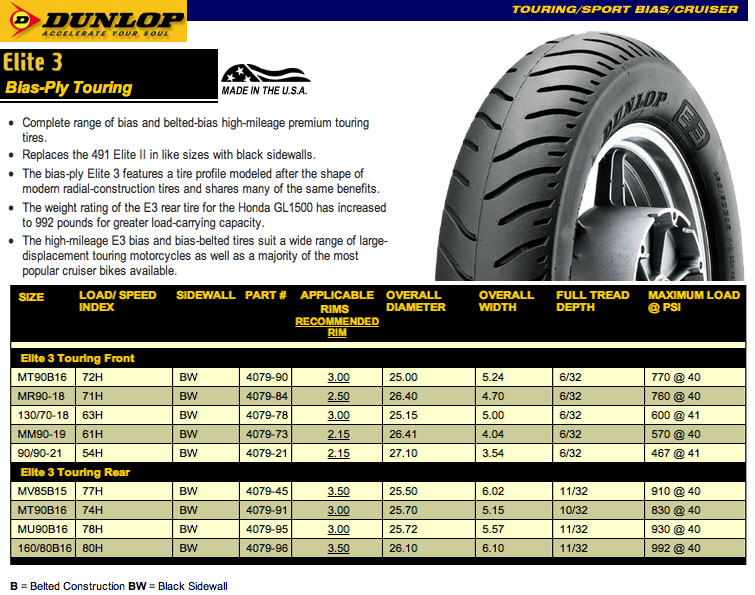 9" Tires 9" Tires | 19-23mm |
| 2.0" Tires | 19-24mm |
| 2.1" Tires | 19-28mm |
| 2.2" Tires | 20-30mm |
| 2.3" Tires | 21-33mm |
| 2.4" Tires | 23-34mm |
| 2.5-2.7" Tires | 25-35mm |
| 2.8-3.1" (plus) Tires | 22-23, 24-25mm |
The process of measuring a kid’s bike wheel and tire size follows similar steps to those shown above, but kid’s bike tires are measured in inches and are understandably smaller than those of an adult bike.
I’ve put together a simple guide for everything to do with kid’s bike sizing.
If you’re looking to measure the wheels on a kid’s bike, or are looking to determine which size bike is best for your kid, have a read of this guide, which includes all of the bike and wheel size charts you’ll need!
Follow the steps within this guide closely, as a poor fitting kids bike can put you child off cycling for good.
Measuring your wheel’s circumference for a bike computer is an important task that will determine the accuracy of the data your computer provides.
To simplify the steps required to measure your wheel’s circumference for a cyclometer, I’ve put together a simple bike wheel circumference guide.
These three simple methods will help you accurately measure your wheel’s circumference.
You won’t need any specialist equipment, apart from a measuring tape.
This may look interesting, but it's one of the easiest ways to measure the circumference of a bike wheel for a bicycle computer!Each type of road bike and mountain bike comes with a different set of average wheel sizes.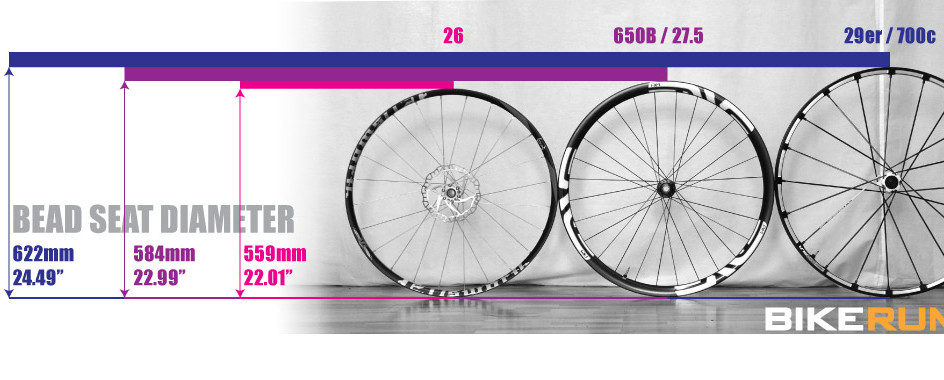 In general, each of these sizes offer a unique set of benefits and drawbacks.
In general, each of these sizes offer a unique set of benefits and drawbacks.
The most common size wheel for a road bike is 700c, and has been the standard size for a number of years.
The 700 refers to the wheel’s diameter of 700 mm, while the “c” is an old French width code for tires.
With “a” characterized as the most narrow width and “d” at the widest, “c” refers to a generally wider size.
Mountain bike wheels come in three main sizes: 26 inches/559 wheels, 27.5 inches/650b wheels, and 29 inches/622 wheels.
The smaller, 26-inch mountain bike wheels were once considered standard size and are more lightweight and agile than larger sized wheels.
Despite their popularity in the past, 26-inch wheels are no longer the standard, as larger wheels have a better grip, traction, and durability and have therefore become more popular.
Both the 27. 5-inch and 29-inch wheels offer a smoother and more controlled ride while sacrificing some of the acceleration capabilities of a 26-incher.
5-inch and 29-inch wheels offer a smoother and more controlled ride while sacrificing some of the acceleration capabilities of a 26-incher.
ISO otherwise known as the International Organization for Standardization developed the ISO wheel size system, which is universal and simplifies the once confusing task of finding the right size wheel for your bike.
The ISO standardization system uses two different numbers, that can often be found printed on the tire or rim walls.
The second number displayed in ISO tire size is the important one and represents the wheel’s bead seat diameter (as shown in the ISO size chart below).
If your wheel rim or tire has no size markings, you can use this ISO wheel size chart after measuring your wheels, to cross-reference and understand more about the size of your bike’s wheels.
| ISO Bead Seat Diameter | Traditional Sizings | Applications | |
|---|---|---|---|
| 137mm | 5.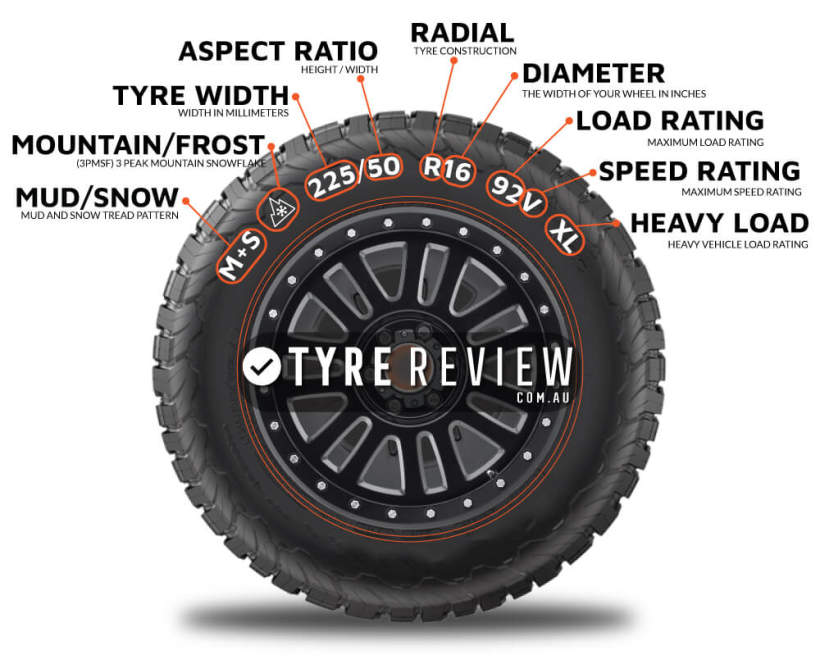 4" 4" | 8 x 11/4 | Wheelchairs |
| 152mm | 6" | 10 x 2 | Wheelchairs |
| 203mm | 8" | 12 1/2 x various | Scooters (children's) |
| 254mm | 10" | 14 x 2.00 | Various (children's) |
| 305mm | 12" | 16 x 1.75 - 16 x 2.125 | Folding bikes, some recumbents |
| 317mm | 12.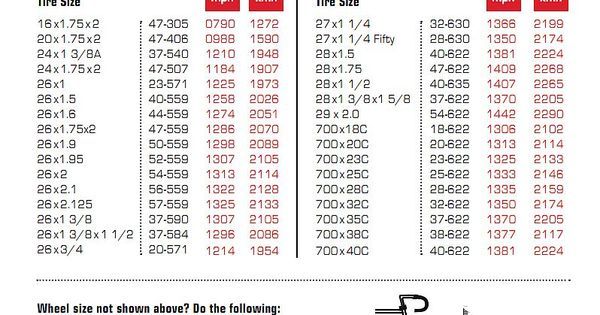 5" 5" | 16 x 1 3/4 | Schwinn (children's) |
| 337mm | 13.25" | 16 x 1 3/8 | Very rare bike tire |
| 340mm | 13.4" | 400 A | Folding bikes, European bikes (children's) |
| 349mm | 13.75" | 16 x 1 3/8 | Folding bikes, recumbents, bikes (children's) |
| 355mm | 14" | 18 x 1.5 - x 2.125 | Folding bikes, bikes (childrens) |
| 369mm | 14. 5" 5" | 17 x 1 1/4 | Moulton bikes |
| 390mm | 15.35" | 450 A | European bikes ( children's) |
| 406mm | 16" | 20 x 1.5 - x 2.125 | BMX, bikes (children's), folding bikes, recumbents |
| 419mm | 16.5" | 20 x 1 3/4 | Schwinn (children's) |
| 440mm | 17.3" | 500A | European bikes (children's), folding bikes |
| 451mm | 17.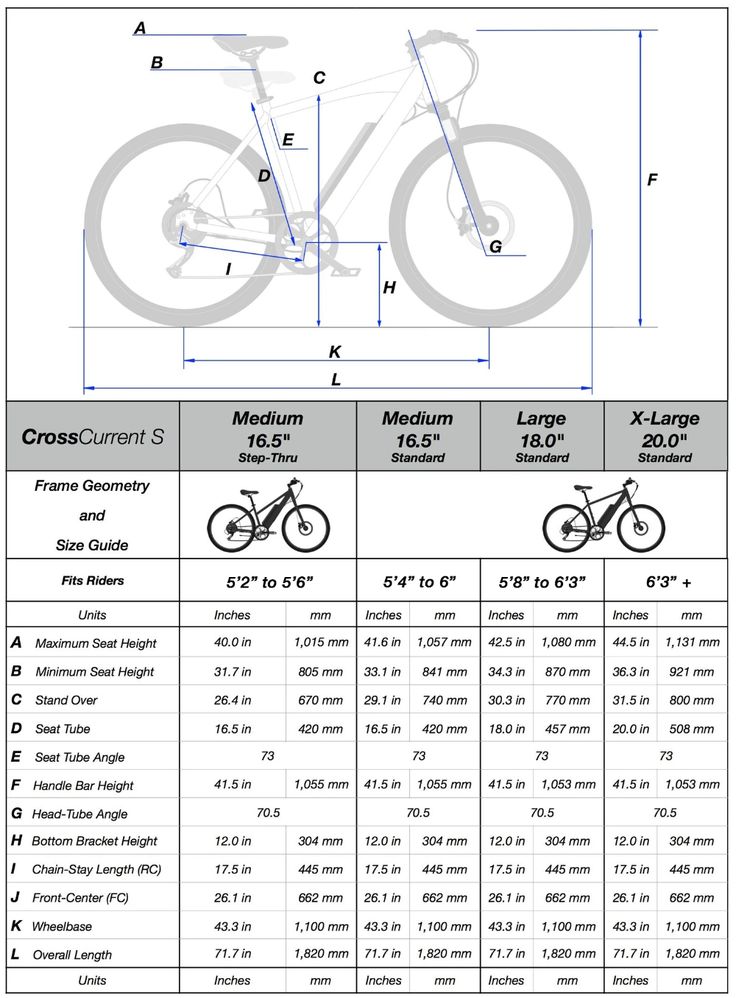 75" 75" | 20 x 1 1/8; x 1 1/4; x 1 3/8 | Bikes (children's), BMX, recumbents, folding bikes |
| 457mm | 18" | 22 x 1.75; x 2.125 | Bikes (children's) |
| 490mm | 19.3" | 550 A | European road bikes (children's) |
| 501mm | 19.75" | 22 x 1 3/8, 22 x 1.00 | British bikes (children's) |
| 507mm | 20" | 24 x 1.5- x 2.125 | Mountain bikes (children's), cruisers |
| 520mm | 20. 5" 5" | 24 x 1, 24 x 1 1/8, 24 x 1 3/4 | Schwinn bikes |
| 540mm | 21.25" | 24 x 1 1/8, 24 x 1 3/8 (E.5), | British bikes (children's), wheelchairs, Japanese women's bikes |
| 547mm | 21.5" | 24 x 1 1/4, 24 x 1 3/8 (S-5) | British bikes (children's), Schwinn bikes (children's) |
| 559mm | 22" | 26 x 1.00- x 2.125, fatbike tires up to 5 inches wide | Mountain bikes, cruisers, fatbikes, Schwinn bikes |
| 571mm | 22. 5" 5" | 26 x 1, 26 x 1 3/4, 650 C | Cannondale bikes, wheels for shorter cyclists, Schwinn bikes |
| 583mm | 22.95" | 700 D | GT bikes |
| 584mm | 23" | 650B, 26 x 1 1/2, 27.5 | French bikes, tandem and touring bikes, Raleigh & Schwinn mountain bikes |
| 590mm | 23.25" | 26 x 1 3/8 (E.A.3), 650 A | French & Italian bikes, English 3 speed bikes |
| 597mm | 23. 5" 5" | 26 x 1 1/4, 26 x 1 3/8 (S-6) | British bikes, Schwinn bikes |
| 599mm | 23.6" | 26 x 1.25, x 1.375 | Old US bikes |
| 622mm | 24.5" | 700 C, 28 x 1 5/8 x 1 1/2, 29 inch, 28 x 1 1/2 F.13 | All bike types, Canadian bikes (F.13), |
| 630mm | 24.8" | 27 x anything (not 27.5), 609mm | Rare Danish bikes, old road bikes |
| 635mm | 25" | 28 x 1 1/2, 700 B, 28 x 1 5/8 x 1 1/2 | European roadsters, old Swedish bikes |
| 686mm | 27" | 32 inch | Unicycles, Custom bikes |
| 787mm | 31" | 36 inch | Unicycles, Custom bikes |
How do you remove a bike wheel?
The process of removing a bike wheel varies based on whether you wish to remove the front or back wheel.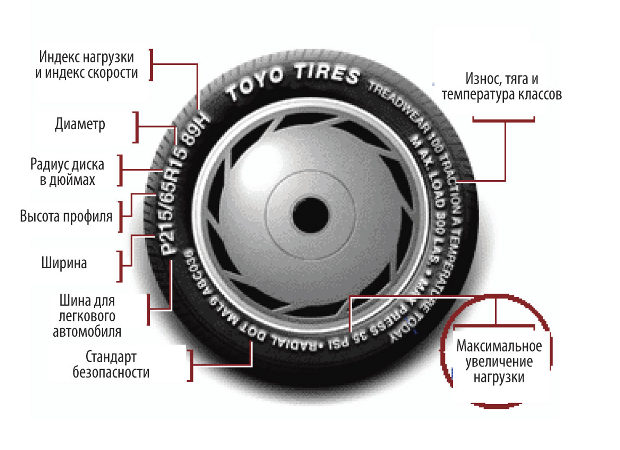
Remove the front wheel by releasing the brake, flipping the bike over, opening its quick-release or unscrewing the wheel nuts, and pulling it off the fork.
Remove the back wheel by shifting the chain down onto the smallest cog, opening the break, loosening your quick release or wheel nuts, then pull the rear derailleur back and remove the wheel at the same time.
Are bike wheels universal?
Bike wheels are not universal.
As bikes come in many different sizes, you’re limited with what size wheels you can use with a bike.
Usually, you’ll be able to make minor adjustments to the size of your wheels or tires, but wheels that are too big or small can easily damage your bicycle.
Can you put a road bike wheel on a mountain bike?
Putting road bike wheels on a mountain bike frame can be done and is a popular option for many commuters who cycle to work in the city but switch back to MTB wheels to hit the trails.
Just remember, as the designs of road and mountain bike wheels vary drastically, you’ll probably need to make adjustments elsewhere on your bike!
But yes, putting road bike wheels on a mountain bike is entirely possible!
Can you put a mountain bike wheel on a road bike?
For improved aerodynamics, the frame of a road bike is typically narrower and offers less wheel clearance than a mountain bike.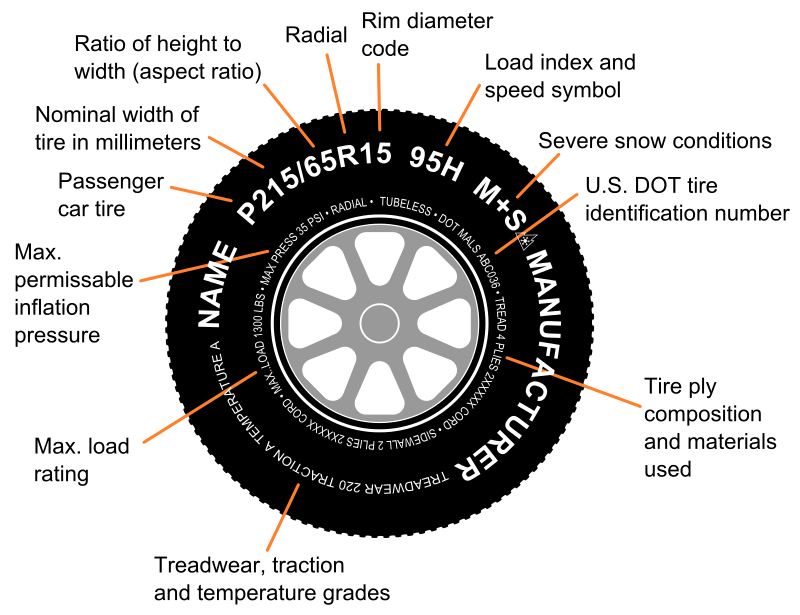
Due to the reduced wheel clearance road bikes typically offer, the wider tires and wheels that accompany a mountain bike are not usually compatible with road bike frames.
That being said, some slimmer 29-inch mountain bike wheels with narrow ties may fit on a road bike that takes 700c wheels.
However, cycling with wheels that are too big can end up causing damage to your bicycle.
If in doubt, don’t risk it.
I hope you found the content within this short article helpful. You should now understand exactly how to measure a bike wheel and how to measure a bike rim for a tire.
If I’ve left any of your questions unanswered, leave me a comment down below and I’ll get back to you straight away.
As always, make sure to use a good quality bike lock to secure your bike, when leaving it unattended.
If you’ve been wondering which size bike frame fits you best, have a read of this short guide, which will help you select the most suitable bike size in a few quick steps.
Lock it or lose it.
Ciao for now.
Your bicycle’s tires might not be something you think about very often, but they have crucial implications for every aspect of your ride. Better understanding how your mountain, gravel, and road bike tire size is measured can help you fine-tune your equipment, and learning how tire size relates to performance can make you faster when it counts. What are the basics of bike tire size?
Bike tires are typically measured in two dimensions— diameter and width. The diameter measurement is an approximation of the tire’s total outside diameter including treads, and the width is a measurement of the approximate total width of the tire when mounted and inflated. For mountain bike tires these dimensions are expressed in inches, while a millimeter-based system called French sizing is used for road, gravel, and track. For example, a 29 x 2. 25 mountain bike tire is about 29” in diameter and about 2.25” wide, while a 700c x 25 road tire is approximately 700mm in diameter and 25mm wide.
25 mountain bike tire is about 29” in diameter and about 2.25” wide, while a 700c x 25 road tire is approximately 700mm in diameter and 25mm wide.
This makes it pretty straightforward to fit a modern tire to a modern rim—a 700c tire will almost definitely fit a 700c road rim (we’ll explain that “c” later), and a 29” tire will likely fit a 29” mountain bike rim. But some obsolete or unusual sizes can be misleadingly labeled, and any tire’s nominal measurements (especially width) are really just approximations. Rim width and tire pressure can significantly influence the size of a tire when mounted and inflated, and tires often measure a bit larger or smaller when installed than the printed dimension would suggest.
To reduce confusion, most tires are also labeled with a second system of measurements called ISO (formerly known as ETRTO). The ISO measurement displays the tire’s nominal width in millimeters, followed by the diameter of the tire’s bead (the surface that actually attaches to the rim) in millimeters (ex: 25 x 622 is a common road tire).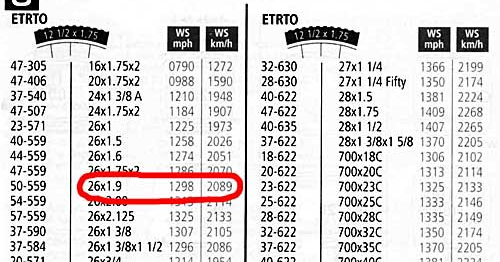 This measurement can help resolve any ambiguity about whether a tire will fit a particular rim, but as with other systems, the ISO measurement of a tire’s width is an approximation and may be impacted by pressure and rim width.
This measurement can help resolve any ambiguity about whether a tire will fit a particular rim, but as with other systems, the ISO measurement of a tire’s width is an approximation and may be impacted by pressure and rim width.
Nearly all modern road bikes use 700c wheels and tires. It used to be widely accepted that narrower tires were faster and 23mm was the standard width. But recent research has proven wider tires to be faster and more comfortable in most situations. As a result, 700c x 25mm and 700c x 28mm are now the most common road tire sizes; many riders prefer even wider widths of 30mm or 32mm. The limiting factor is usually the bike itself, with some frames unable to accommodate tires beyond a certain width. Most new road frames can at least fit up to 28mm tires but double-check your frame’s allowance before sizing up.
A few other less common wheel and tire sizes exist for road bikes. 650b (ISO 584) and the rarer 650c (ISO 571) are two examples, both sometimes used on bikes for smaller riders. The letter that follows the diameter measurement in French tire sizes originally delineated width, but it’s now mostly just useful to differentiate between similarly-named but incompatible sizes. For instance, a 650b tire will not fit on a 650c rim.
The letter that follows the diameter measurement in French tire sizes originally delineated width, but it’s now mostly just useful to differentiate between similarly-named but incompatible sizes. For instance, a 650b tire will not fit on a 650c rim.
It’s also important to understand the different types of mutually-incompatible road tires. Clinchers are most common; these are the familiar tires that seat into a walled rim around an inner tube. Certain clincher rims can also be used with tubeless tires, which use a liquid sealant in place of an inner tube. Finally, tubular tires are permanently sewn closed around an internal tube and are glued into a specially-made rim. All 3 of these tire types use the same sizing standards and terminology but are generally not interchangeable.
Tires are printed with a manufacturer’s recommended pressure range, and road riders used to think inflating their tires to the highest possible pressure was fastest. But with the move to wider tires has also come a trend towards lower pressure. The science of tire pressure is complicated, but wider tires require less pressure for the same volume of air than narrower tires, allowing for a more comfortable ride. Additionally, wider tires at lower pressures reduce bouncing and are actually faster on most surfaces than smaller, harder tires.
The science of tire pressure is complicated, but wider tires require less pressure for the same volume of air than narrower tires, allowing for a more comfortable ride. Additionally, wider tires at lower pressures reduce bouncing and are actually faster on most surfaces than smaller, harder tires.
It’s tough to make a generalized recommendation for pressure—riding conditions, your weight, and the tire’s size all play a part. But generally, the larger the tire and the rougher the surface, the lower the optimal pressure. With each 3mm increase in tire width, you can usually reduce pressure by 1 Bar (~14 psi). Also, tubeless tires can generally be ridden at lower pressures than tubed tires of the same size. Some tire and rim manufacturers have calculators on their websites that make personalized recommendations for pressure; these are a great starting resource to make your ride faster and more efficient.
Adaptive Training
Get the right workout, every time with training that adapts to you.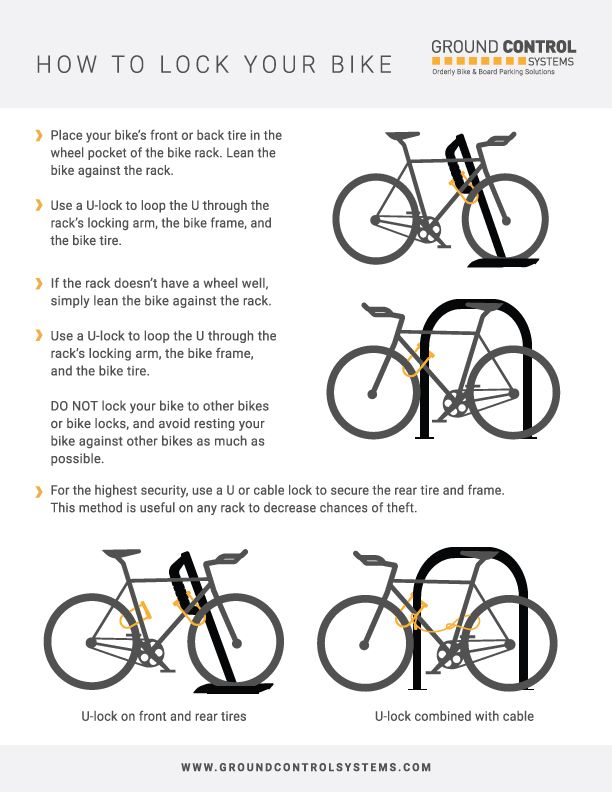
Check Out TrainerRoad
Mountain bike tires are measured in inches and are offered in 3 non-interchangeable diameters corresponding to common mountain bike wheel sizes. Most popular for high-end mountain bikes are 29” tires and wheels. Next come 27.5” setups, preferred by some riders who like smaller, slightly more maneuverable wheels. And finally, 26” wheels and tires used to be the standard, but are now found mostly on entry-level and kids’ bikes.
Tires at each of these diameters are available in a wide variety of widths, which riders select for the specifics of their discipline and terrain. Cross-country racers usually choose comparatively narrow tires ranging from 1.9” to 2.25” wide. Trail, all-mountain, and enduro bikes are normally equipped with wider tires between 2.25” and 2.4”, and downhill tires are even wider at 2.4” to 2.6”. Finally, fat bike tires are mounted on purpose-built rims and push the boundaries even further, sometimes measuring as wide as 5”. The specifics of tire choice are carefully considered by mountain bikers, with racers often choosing different widths and tread patterns depending on the course and conditions.
The specifics of tire choice are carefully considered by mountain bikers, with racers often choosing different widths and tread patterns depending on the course and conditions.
Interestingly, most mountain bike wheel sizes are actually the same diameter as road wheels—29” wheels are equivalent to 700c, while 27.5” are the same as 650b. But you wouldn’t want to put tires intended for one on a wheel intended for the other, as the rim’s width is dramatically different for road and mountain bikes and would interfere with the tire’s performance.
Tire pressure is a crucial concern in mountain biking. Small changes in pressure can dramatically impact performance and handling on the trail, and experienced mountain bikers regularly adjust pressure depending on terrain, conditions, riding style, and tire choice.
Because all of these variables are factors to consider, it’s nearly impossible to make a general recommendation for mountain bike tire pressure. Online calculators can help suggest a starting pressure based on equipment, weight, and conditions, but in the end, it’s ultimately a matter of personal preference and learning from experience. A good strategy is to treat the first few rides on a new setup or in new terrain as experiments. Carry a digital gauge, start with pressure on the higher side, and gradually let a few psi out/ add some pressure back in as you ride to experiment with what works and feels best. Check and record your pressure when you find the sweet spot and use this as your starting point for future rides.
Online calculators can help suggest a starting pressure based on equipment, weight, and conditions, but in the end, it’s ultimately a matter of personal preference and learning from experience. A good strategy is to treat the first few rides on a new setup or in new terrain as experiments. Carry a digital gauge, start with pressure on the higher side, and gradually let a few psi out/ add some pressure back in as you ride to experiment with what works and feels best. Check and record your pressure when you find the sweet spot and use this as your starting point for future rides.
There are a few general principles to keep in mind when finding the right pressure. Typically, the larger your tire, the lower the optimal pressure. Tires with thinner casings require higher pressure, as do heavier riders. Rocky terrain may also necessitate higher pressure to avoid flats, while lower pressures can be used in smooth, grassy, or muddy conditions. Finally, some riders like to use tire inserts, which provide more flat protection and allow a few psi reduction in pressure.
Gravel, cyclocross, and track cyclists also choose specific tire sizes and pressures to optimize performance.
Cyclocross bikes use 700c road wheels, so cyclocross tires are all designed for this standard diameter. In the past, most serious cyclocross racers used tubular tires, but tubeless tires have become increasingly popular over the last few seasons. Tires at CX events have traditionally been allowed up to a maximum width of 33mm, and UCI-governed events still impose this limit. Non-UCI races often allow larger tires, such as the 38mm maximum width allowed at USA Cycling masters, collegiate, and single speed national championships. Many local events impose no size restrictions at all—check your race’s rules to know for sure.
Gravel bikes used to be repurposed cyclocross bikes, but with dedicated gravel equipment introduced over the last few years tire options have greatly expanded. Most gravel bikes use 700c wheels, but 650b wheels are occasionally used for especially technical trail riding and bikepacking. Most new gravel bikes have clearance for tires ranging up to at least 42 or 45mm width, and some allow for even wider tires. Virtually all gravel riders use tubeless tires.
Most gravel bikes use 700c wheels, but 650b wheels are occasionally used for especially technical trail riding and bikepacking. Most new gravel bikes have clearance for tires ranging up to at least 42 or 45mm width, and some allow for even wider tires. Virtually all gravel riders use tubeless tires.
Gravel tires all balance speed and efficiency with offroad traction. Narrower tires with minimal treads are fastest on hardpack and paved surfaces but offer poor grip in loose corners. Wider tires with more aggressive tread patterns are more capable on loose terrain but roll much more slowly on smooth or paved roads. Gravel riders choose the width and tread pattern that offers the best balance for their local terrain, but may significantly adjust their tire choice and pressure for different conditions.
Like road bikes, track bikes use 700c wheels. But unlike on the road where slightly wider and softer tires are usually faster, on a smooth track harder and narrower tires have an advantage.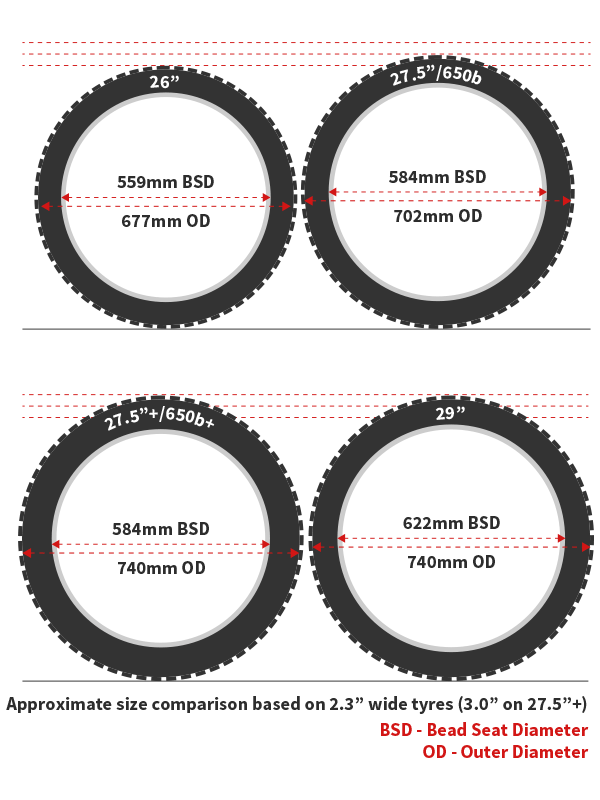 For this reason track racers still prefer 21mm – 23mm wide tubular tires inflated to very high pressures—usually 150 psi or more on indoor tracks. Racers on rougher outdoor tracks don’t inflate their tires quite this high, but they still use much more pressure than they would on the road, with relatively narrow tires offering little in the way of puncture protection.
For this reason track racers still prefer 21mm – 23mm wide tubular tires inflated to very high pressures—usually 150 psi or more on indoor tracks. Racers on rougher outdoor tracks don’t inflate their tires quite this high, but they still use much more pressure than they would on the road, with relatively narrow tires offering little in the way of puncture protection.
| Tire Size | Use/ Discipline | ISO Designation |
|---|---|---|
| 700c x 23mm – 32mm | Road/Track | 622 |
| 700c x 35mm – 50mm | Gravel and Mixed surface | 622 |
| 650b x 23mm – 25mm | Small road bikes | 584 |
| 650b x 45mm – 50mm | Gravel and Bikepacking | 584 |
| 26” x 2.1” – 2.3” | Cross Country MTB | 559 |
| 26” x 2.3” – 2.5” | Trail | 559 |
| 26” x 2.4” – 2.6” | Enduro/ Downhill | 559 |
27.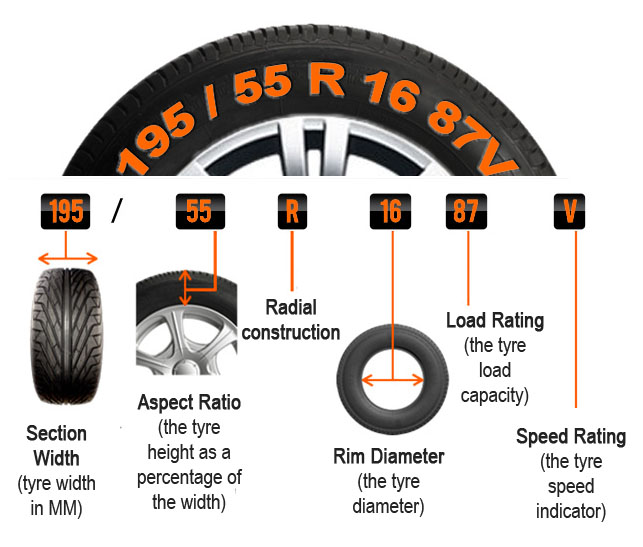 5” x 2.1” – 2.3” 5” x 2.1” – 2.3” | Cross Country MTB/ Gravel | 584 |
| 27.5” x 2.3” – 2.5” | Trail | 584 |
| 27.5” x 2.4” – 2.6” | Enduro and Downhill | 584 |
| 29” x 2.1” – 2.3” | Cross Country MTB | 622 |
| 29” x 2.3” – 2.5” | Trail | 622 |
| 29” x 2.4” – 2.6” | Enduro and Downhill | 622 |
bike tire pressurebike tire sizegravel bike tiresmountain bike tiresroad bike tires
Nikolaev bicycle shop "Sportek"
Published: 04/07/2017
Edited: 07/15/2018
From time to time the question arises: “What is the diameter of the bicycle wheels?”
Most often, it pops up if a tire has broken through or new tires are needed for the wheel of an old bicycle. And to the seller’s question “What wheel does your bike have?” Only one answer comes to mind: “round”.
And to the seller’s question “What wheel does your bike have?” Only one answer comes to mind: “round”.
First of all, you need to define the concept of wheel diameter .
For most ordinary people, this is the diameter of the wheel at the outer (outer) border of the tire.
But there is also the concept of rim fit size - this is the diameter of the rim or tire itself along the inner border.
Therefore, it would be a good idea to first understand the tire marking systems adopted in the world in order to speak the same language with the bike shop salesperson. You can read about this in the article "Bicycle tires: sizes, marking types and interchangeability" on our website.
For the sake of brevity, here is a figure explaining what is measured in each labeling system. Therefore, it is important to understand what we measure and what we want to find.
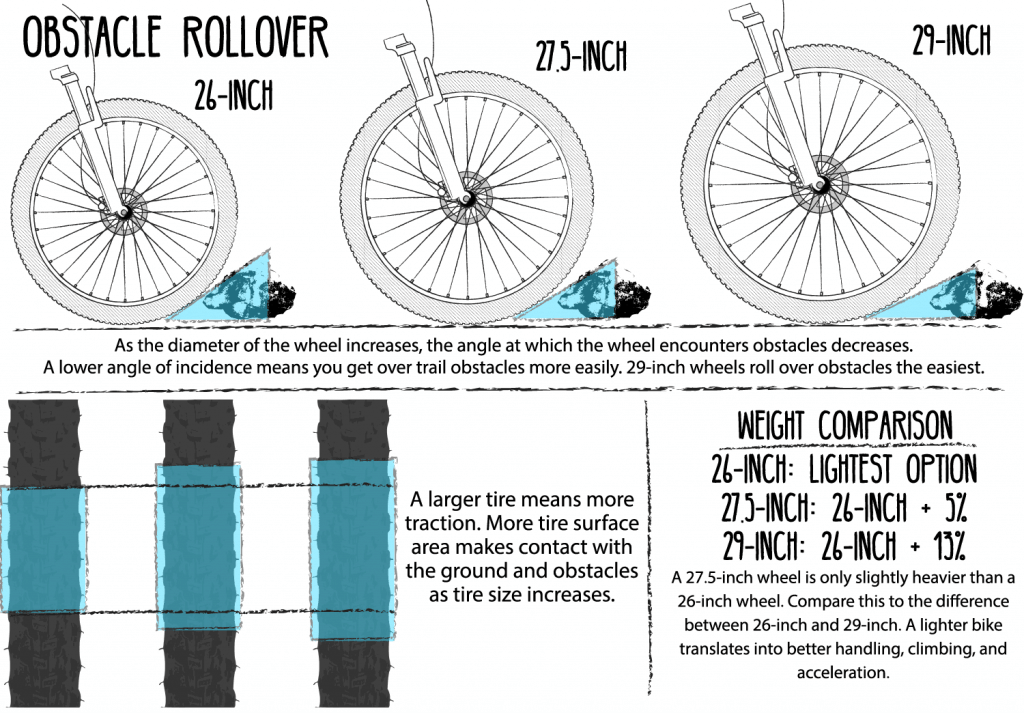 An old tire mounted on a bicycle, , should have its diameter written in inches or millimeters.
An old tire mounted on a bicycle, , should have its diameter written in inches or millimeters. When choosing a new rubber, be guided by it. If there is no tire with exactly the same marking, look at the interchangeability table and select the right size in another marking.
If a new tire is needed a little wider or narrower, check the tire and rim width chart.
If in doubt, talk to the salesperson. He will tell you if it is right for you, both in terms of size, tread, riding style and what kind of roads you want to ride.
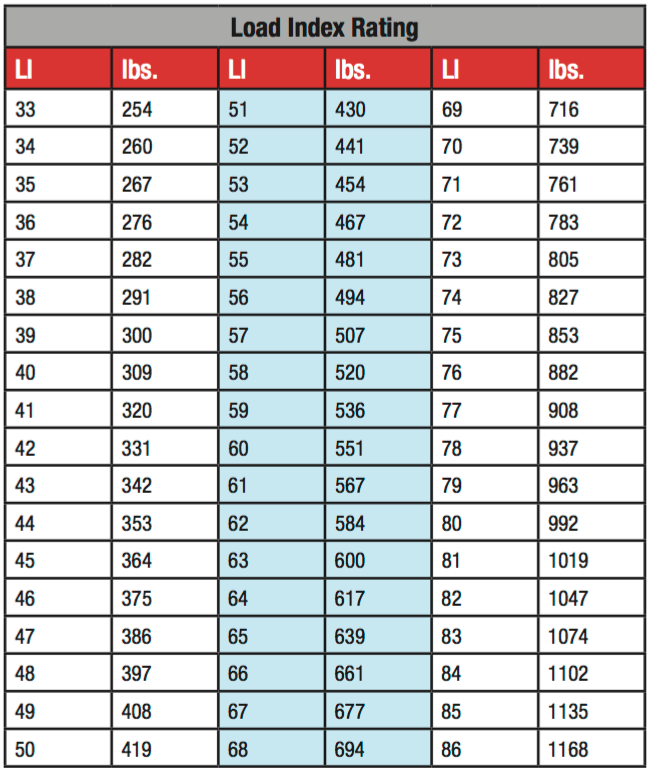
This can be done by measuring the radius and multiplying it by two.
For younger students reading this article, I remind you that one diameter consists of two radii.
Only you need to measure strictly from the center of the sleeve, and not from its edges. When measuring, the bike should stand vertically, and the tape measure, putting one end to the ground, keep the same strictly vertically, and not along the spokes of the wheel . Only such a measurement will give the correct value.
The wheel diameter itself can be measured in the same way. The main thing is to accurately determine its upper cut. To do this, you can take a level and attach it to the top of the tire, and, holding it strictly horizontally, determine the desired size from the tape measure.
After that, we convert it from mm to inches. To do this, divide it by 25.4 (1 inch = 25.4 mm) and calculate the size in inches. The result can be rounded up to standard inch wheel sizes.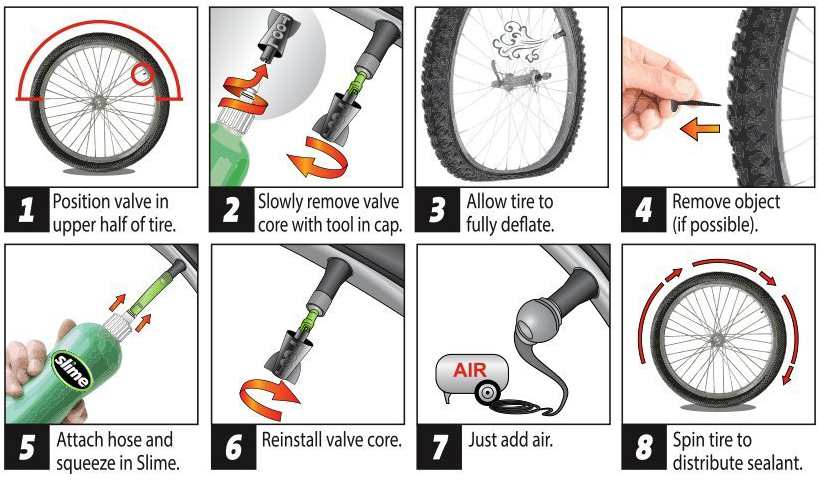
For example, if the measurement is 720 mm, divide by 25.4 to get 28.346 inches. So, most likely, the actual size of the wheel, taking into account the accuracy of the calculations, is 28”.
In principle, the rim diameter can also be measured in the same way.
Just pay attention to the difference between what is measured on the outside of the tape measure and the fit size of the rim.
And knowing it, it is easy to calculate the diameter. To do this, the circumference in millimeters must be divided by the number "Pi" (3.14). Once you get the diameter in mm, divide it by 25.4 to get the diameter in inches. Similarly to the previous paragraph, the result will have to be rounded to the nearest whole number in inches. The more accurate all measurements, the more accurate the result and the less rounding.
The more accurate all measurements, the more accurate the result and the less rounding.
Comments (2)
x
Nikolaev bicycle shop "Sportek"
Published: 01/27/2017
Edited: 06/01/2021
Sooner or later, almost every cyclist faces the question of replacing the rubber on the wheel or the cameras for them.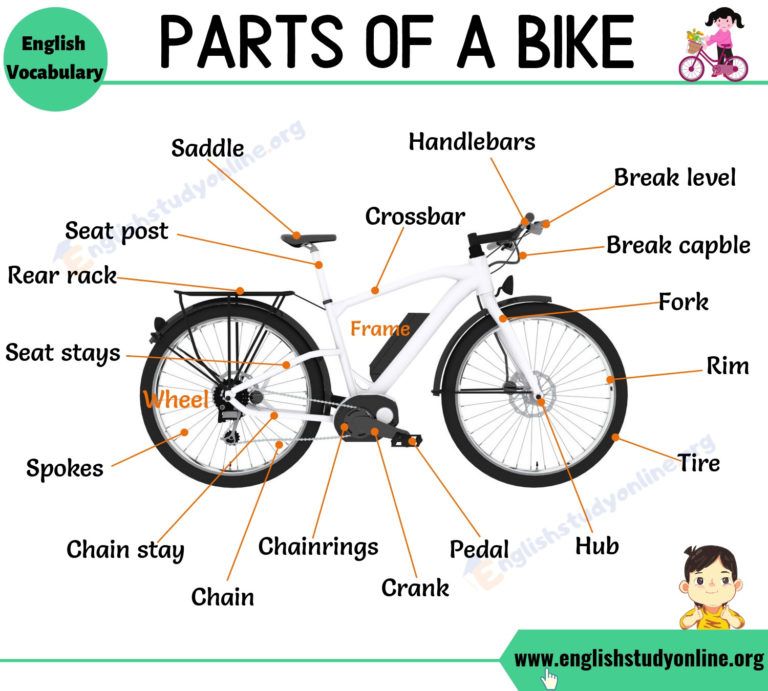
The easiest way, of course, is to look at the size of the tire currently installed on the bike (it is written on the side of it), and look for exactly the same. On some rims, their landing diameter and width are also written.
In life, everything is always a little more complicated and it often happens that the tire you like has a marking that is not entirely clear or does not match the marking on your rubber. Sometimes it is necessary to replace the old bicycle rubber, which has served for many years, with a more modern one.
What to do? You can’t put a tire on a bike over the Internet, but you don’t want to pay money just like that.
In this article, we will try to help you understand the markings on bicycle tires and find out which of them are interchangeable.

The first thing to know when choosing a tire is the wheel size. They are usually measured in inches, but sometimes in mm. There are not very many of them and the most common are 16, 18, 20, 24, 26, 27.5, 28, 29.
At the same time:
Further, what else you need to know is the seat size (diameter) of the rim or BSD (eng. Bead Seat Diameter). It is the most important and determines the interchangeability of tires. If this number matches at the rim, tire, or tube, then that tire or tube fits those rims. And if the width of the new rubber can be changed, then the landing size will not change much.
If the size (numbers in mm) is written on the wheel (rim), for example, as in the photos above, they accurately indicate the fit size of the rim and its width, which is the main data for selecting the inner tube and tire for the wheel.
There are several types. The confusion in the designation of sizes began in the middle of the 20th century, and today Great Britain and France use their own designations for marking.
Previously, the sizing system was based on the outside diameter of the tires. It was measured in inches (24", 26", 28") or in millimeters (500, 650, 700, etc.).
Over time, this system lost its meaning, because different products with the same outer diameter wheels (together with the height of the tire) did not match the inner diameter (rim diameter) on which this tire was put on.There were also marketing moves of manufacturers, and the accuracy of translation and rounding of measurements in inches is lower than in millimeters.0003
To overcome these confusions and bring all sizes to the same standard, the International Organization for Standardization (ISO - International Organization for Standardization) has developed a universal system for designating tire sizes - ISO 5775 . This system was previously known as " ETRTO ". It was proposed by the organization of the same name: ETRTO (European Tire and Rim Technical Organization or in Russian: "European technical organization for rims and tires").
This system was previously known as " ETRTO ". It was proposed by the organization of the same name: ETRTO (European Tire and Rim Technical Organization or in Russian: "European technical organization for rims and tires").

At first it was in the form of a number and a letter, for example, 700C - 700 the outer diameter of the tire is in mm. The letter determined the width from "A" - the narrowest to "D" - the widest.
Now the marking has acquired a more modern look. For example: 700 x 35C. Here the outer diameter of the tire is 700 mm and its width is 35 mm. The letter at the end indicates the inner (landing) diameter. In this case, "C" is 622 mm.
 Those. first inner diameter tire (rim size ) - 533 mm, and then its width - 37 mm. (instruction for Soviet bicycles: "SPORT", "Salyut")
Those. first inner diameter tire (rim size ) - 533 mm, and then its width - 37 mm. (instruction for Soviet bicycles: "SPORT", "Salyut")
Note a very important nuance and paradox in inch sizes. Tire sizes can be specified as a decimal fraction, such as 26x1.75, or as a simple fraction, such as 26x1 3/4.
Mathematically, these fractions are equal: 1.75 = 1 3/4.
But, in terms of fit size and tire width in millimeters, this is not always the case, and the most unpleasant thing is that tires with such dimensions can be not interchangeable with .
And this circumstance should always be taken into account when purchasing a new bike tire.
In the table below, we have tried to collect the most common tire size designations in different systems and show their compatibility.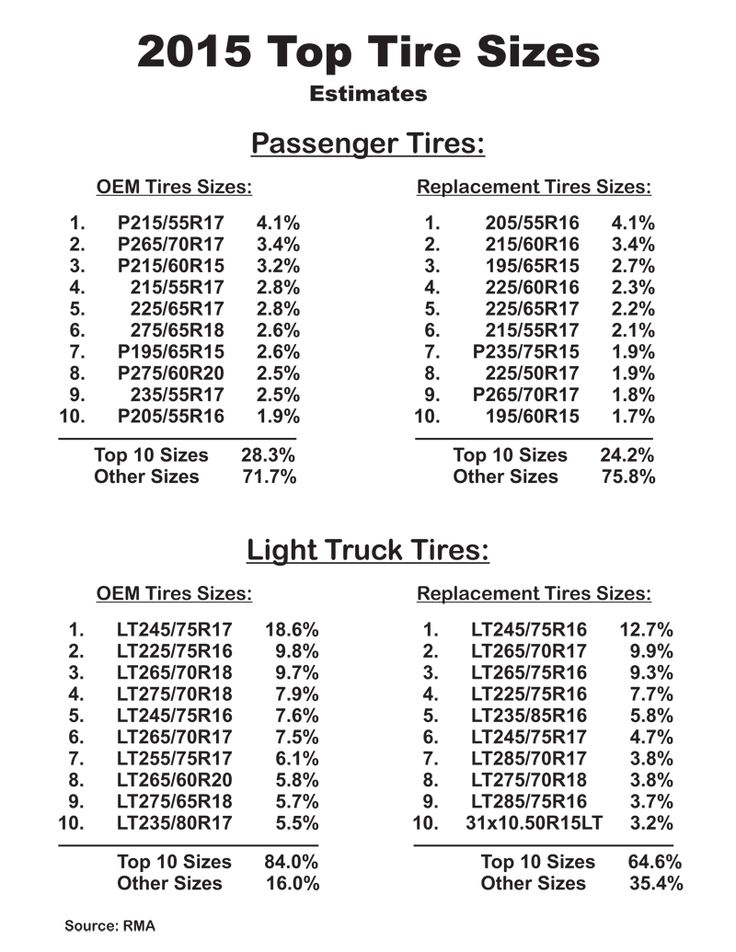
Perhaps not all dimensions encountered in life were taken into account, but if you have a tire with dimensions not listed in the table, try to estimate its dimensions based on similar nearest or similar dimensions.
| Rim bore size in mm according to ISO | Tire size in plain and decimal inches | French tire size | Tire size in mm according to ISO (width - bore) | Explanations |
| 681 | 22-681 | Sports track bike B-64 "Record" KhVZ (1958) | ||
| 642 | 28 x 1 5/8 x 1 1/2 | 700-28A | 28-642 | Obsolete size |
| 28 x 1 3/8 | 700-35A | 37-642 | ||
| 635 | 28 x 1 1/2 x 1 1/8 | 700-28B | 32-635 | American, English, Danish, Chinese, Indian Road Models |
| 28 x 1 1/2, 28 x 1 1/2 x 1 5/8 | 700-38B, 700B Standard | 40-635 | ||
| 28 x 1 5/8 x 1 1/2 | 44-635 | |||
| 630 | 27 x 7/8 | 22-630 | Road bikes, including older models | |
| 27 x 1 | 25-630 | |||
| 27 x 1 1/8 | 28-630 | |||
| 27 x 1 1/4 | 32-630 | |||
| 27 x 1 3/8 | 37-630 | |||
| 27 x all options | ||||
| 622 | 29 x all variants | 700C | This size was invented by marketers for tires with a bore diameter of 622 mm. They differ from 28 only in tire height. They differ from 28 only in tire height. | |
| 28 x decimal | 700C | For 622 mm tires | ||
| 28 x 3/4 | 700-18C 700x18C | 18-622 | ||
| 700-19C 700x19C | 19-622 | |||
| 28 x 3/4 | 700-20C 700x20C | 20-622 | ||
| 28 x 1 28 x 7/8 | 700-23C 700x23C | 23-622 | ||
| 28 x 1 | 700-25C 700x25C | 25-622 | ||
| 28 x 1 1/8, 28 x 1 5/8 x 1 1/8 | 700-28C 700x28C | 28-622 | ||
| 28 x 1.20 | 700-30C 700x30C | 30-622 | ||
| 28 x 1 3/4, 28 x 1.5 | 700x38C 700-40C | 40-622 | Road bikes: "Ukraine", "Minsk", "Sura", "Velta", "Aist" (111-321, 111-322) | |
| 28 x 1 1/2, 28 x 1 5/8 x 1 3/8 | 700C 700x35C 700x38C | 35-622 | Road bikes: "Ukraine", "Minsk", "Sura", "Velta", "Aist" | |
| 27 x 1 1/4, 28 x 1 5/8 x 1 1/4 | 700-32C 700x32C | 32-622 | Road and sports touring bikes, "Tourist", "Sport", "Sputnik" | |
| 28 x 1 5/8 x 1 1/4 | Obsolete Canadian designation F13 | |||
28 x 1.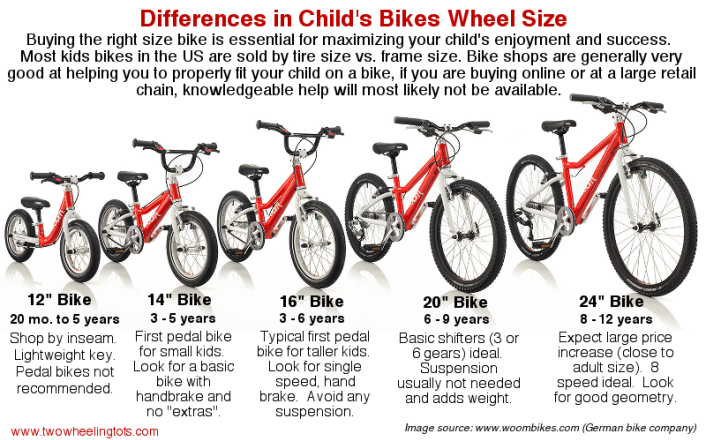 4 4 | 700-35C 700x35C | 35-622 | Road bikes | |
| 28 x 1.5 | 700x38C 700-38C 700-40C 700x40C | 40-622 | ||
| 28 x 1 3/8 x 1 5/8 | 37-622 | |||
| 28 x 1.6 | 700-42C 700x42C | 42-622 | ||
| 28 x 1.6 | 700-44C 700x44C | 44-622 | ||
| 28 x 1 5/8 x 1 3/4 | 700-45C 700x46C | 45-622 | ||
| 28 x 1.75, 28 x 1 5/8 x 1 3/4 | 700-47C 700x47C | 47-622 | ||
| 28 x 2.00 | 700-50C 700x50C | 50-622 | ||
| 600 | 22 (23, 24, 25, 27, 28, 30)-600 | Old Soviet sports and track bikes | ||
| 599 | 26 x 1.25, 26 x 1.375 | 32-599 | Very old American light bicycles.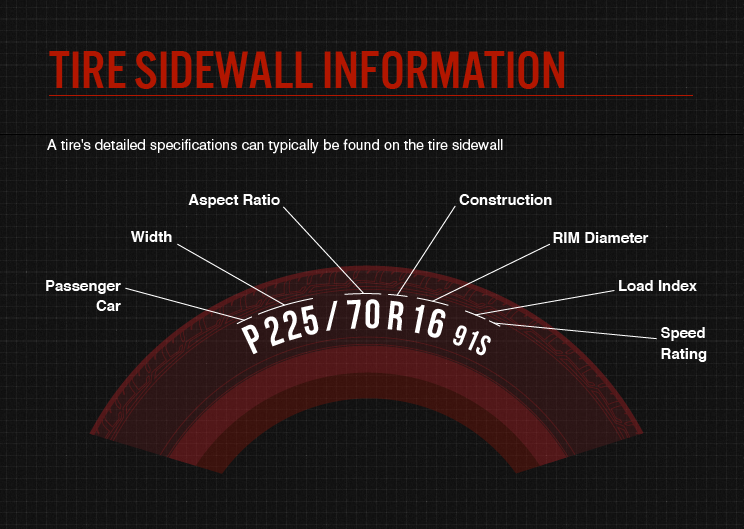 | |
| 26 x 1 7/8 | 47-599 | ZiF (Penza) 190-535 "Samson" | ||
| 597 | 26 x 1 1/4 (EA1) (England) | 32-597 | English old sports and club bikes. | |
| 26 x 1 3/8 (S-6) | 37-597 | Light bicycles of the American firm Schwinn. | ||
| 590 | 26 x 1 1/8 | 28-590 | Soviet bicycles ZiF (Penza) "Diana", "Prima", "Turn", "Relay", "Sura", "Breeze", "Temp" American and English 3 and 10 speed. | |
| 26 x 1 1/4 | 32-590 | |||
| 26 x 1 3/8 (E.A.3) (England) | 650A | 35-590 | ||
| 26 x 1 3/8 | 650-35A 650x35A | 37-590 | ||
| 26 x 1 5/8 | 44-590 | |||
| 587 | 700D | Old size on some GT models | ||
| 584 | 27. 5 x 1.50 5 x 1.50 | 650x38B | 40-584 | French road bikes, touring bikes with cargo, tandems, some Raleigh (USA), old Schwinn mountain bikes |
| 26 x 1 1/2 | 650B | 37-584 | ||
| 27.5 x 1.5 | 40-584 | |||
| 27.5 x 1.65 | 44-584 | |||
| 27.5 x 1.75 | 47-584 | |||
| 27.5 x 2 | 52-584 | |||
| 27.5 x 2.1 | 54-584 | |||
| 27.5 x 2.25 | 57-584 | |||
| 27.5 x 2.3 | 60-584 | |||
| 27.5 x 2.4 | 62-584 | |||
| 27.5 x 2.8 | 70-584 | |||
| 571 | 26 x 3/4 | 650x20C | 20-571 | Triathlon, time trial, small road bikes, some French Peugeot bikes. |
| 26 x 7/8 | 650x23C | 23-571 | ||
| 26 x 1 | 650C | 23-571 | ||
26 x 1.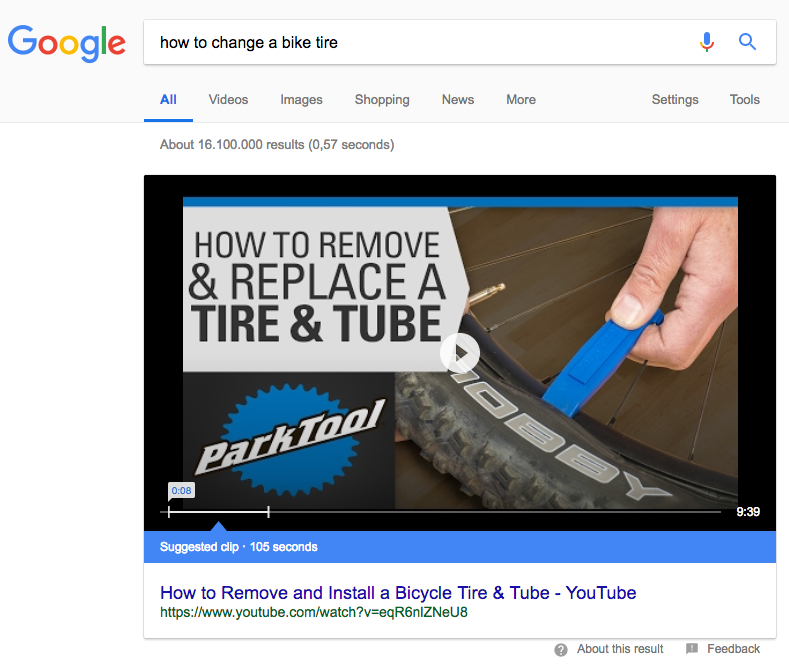 75 75 | 47-571 | |||
| 26x1 3/4 (S-7) | Road Schwinn | |||
| 559 | 26 x 1.0 | 25-559 | Most mountain bikes. Classic landing diameter for 26 wheels. | |
| 26 x 1.25 | 32-559 | |||
| 26 x 1.35 | 35-559 | |||
| 26 x 1.4 | 37-559 | |||
| 26 x 1.5 | 40-559 | |||
| 26 x 1.6 | 44-559 | |||
| 26 x 1.75 26 x 1.75 x 2 | 47-559 | |||
| 26 x 1.95 | 50-559 | |||
| 26 x 2.00 | 52-559 | |||
| 26 x 2.10 | 54-559 | |||
| 26 x 2.15 | 55-559 | |||
26 x 2.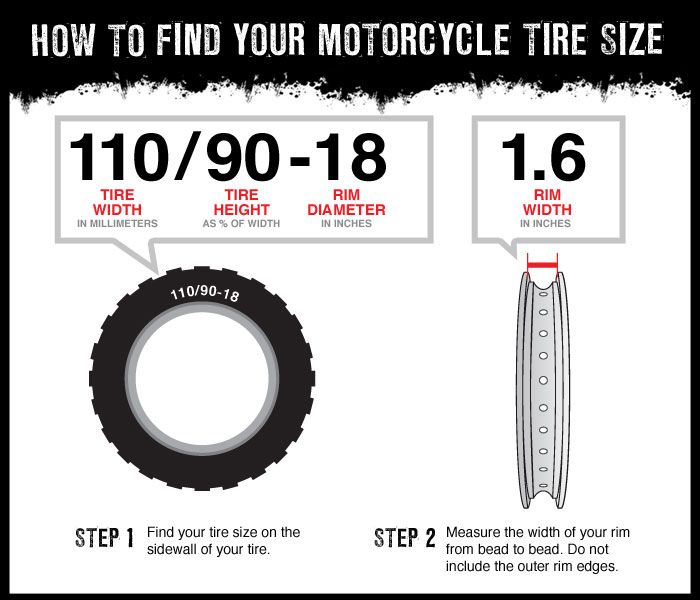 25 25 | 57-559 | |||
| 26 x 2.3 | 60-559 | |||
| 26 x 2.4 | 62-559 | |||
| 26 x 3.0 | 75-559 | |||
| 26 x 3.7 | 95-559 | |||
| 26 x 4.00 | 100-559 | |||
| 26 x 4.5 | 115-559 | |||
| 26 x 4.8 | 120-559 | |||
| 547 | 24x1 1/4 | English children's and American firm Schwinn | ||
| 24x1 3/8 (S-5) | Schwinn American children's bicycles | |||
| 540 | 24 x 1 1/8 | 600A | 28-540 | Children's English and European bicycles, most wheelchairs |
| 24 x 1 1/4 | 32-540 | |||
| 24 x 1 3/8(E-5), 24 x 1 3/8 A | 37-540 | |||
| 533 | 24 x 1 1/2 | 37-533 | "Salute", "Altair", "Ervi", "Eaglet", "Erelyukas", "Swallow" ("Kregzdute", "Kregzhdute" - Siauliai bicycle factory "Vairas", Lithuania). Be careful when replacing because not all 24" tires will fit 533 wheels. | |
| 531 | 24 x 1 5/8 x 1 1/2 | 44-531 | ||
| 520 | 24x1 | 25-520 | Road wheels for children's bikes | |
| 507 | 24 x 1.5 | 40-507 | Children's mountain. "Salute", "Altair", "Ervi" | |
| 24 x 1.75 | 47-507 | |||
| 24 x 1.95 | 50-507 | |||
| 24 x 2.0 | 51-507 | |||
| 24 x 2.125 | 54-507 | |||
| 24 x 2.25 | 57-507 | |||
| 24 x 2.35 | 60-507 | |||
24 x 2. 5 5 | 62-507 | |||
| 24 x 2.6 | 65-507 | |||
| 24 x 2.75 | 70-507 | |||
| 24 x 3.0 | 75-507 | |||
| 501 | 22 x 1.0 | 25-501 | European bikes | |
| 22 x 1 1/4 | 32-501 | |||
| 22 x 1 3/8 | 37-501 | |||
| 490 | 550-28A | 28-490 | European Road Kids Bikes | |
| 22 x 1 3/8 x 1 1/4 | 550-32A | 32-490 | ||
| 22 x 1 3/8 | 550-35A | 37-490 | ||
| 489 | 22 x 1.0 | 25-489 | European bikes | |
| 22 x 1 3/8 | 37-489 | |||
| 22 x 1 3/8 x 1 1/4 | 40-489 | |||
22 x 2. 00 00 | 50-489 | |||
| 457 | 22 x 1.75 to 2.125 | Children's bicycles | ||
| 451 | 20 x 1 1/8 | 28-451 | BMX for light riders, light children's bikes, some ligerades. Wheels on some types of wheelchairs. | |
| 20 x 1 1/4 | 30-451 | |||
| 20 x 1 3/8 | 37-451 | |||
| 445 | 20 x 1 1/4 | 30-445 | "Schoolboy" (old Soviet models) | |
| 440 | 500-28A | 28-440 | European folding, children's bicycles | |
| 500-35A | 37-440 | |||
| 20 x 1 1/2 | 500-38A | 40-440 | ||
| 438 | 20 x 1 3/8 | 37-438 | European bikes | |
| 20 x 1 3/8 1 1/2 | 40-438 | |||
| 432 | 20 x 2 1/2 | 40-432 | European bikes | |
| 428 | 20 x 2.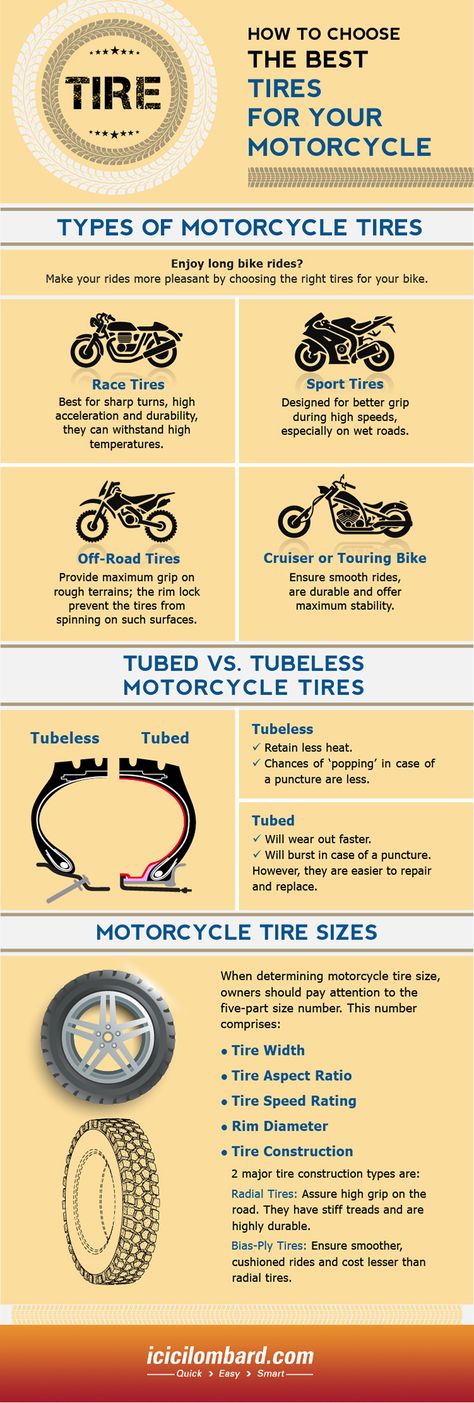 00 00 | 54-428 | European bikes | |
| 419 | 20 x 1 3/4 | Schwinn American children's bicycles | ||
| 406 | 20 x 1.25 | 32-406 | Most BMX bikes, kids and folding models. "Venta" (folding model 175-811). "Stork" (folding, model 113-322) "Tisa-2", "Cross", "KAMA", "DESNA", "Schoolnik", "Velta Kama", "Dubisa" (Siauliai bicycle factory), "Eureka" and other folding and old Soviet models. Folding "Mustang" | |
| 20 x 1.35 | 35-406 | |||
| 20 x 1 3/4 20 x 1.5 | 40-406 | |||
| 20 x 1.75, 20 x 1.75 x 2 | 47-406 | |||
| 20 x 1.95 | 50-406 | |||
| 20 x 2.00 | 54-406 | |||
20 x 2. 125 125 | 57-406 | |||
| 20 x 2.35 | 60-406 | |||
| 20 x 2.5 | 62-406 | |||
| 20 x 2.6 | 65-406 | |||
| 20 x 2.75 | 70-406 | |||
| 20 x 3.0 | 75-406 | |||
| 390 | 18 x 1 1/8 | 450-28A | 28-390 | Children's European bikes |
| 18 x 1 3/8 | 450-35A | 37-390 | ||
| 450-55A | 55-390 | |||
| 387 | 18 x 1 1/2 | 37-387 | Children's European bikes | |
| 369 | 17 x 1 1/4 | 32-369 | Bicycles Alex Moulton | |
| 355 | 18 x 1 1/8 | 28-355 | Children's bicycles | |
18 x 1. 25 25 | 32-355 | |||
| 18 x 1.35 | 35-355 | |||
| 18 x 1.5 | 40-355 | Birdy folding bikes. | ||
| 18 x 1.6 | 42-355 | Children's bicycles | ||
| 18 x 1.75 | 47-355 | |||
| 18 x 1.95 | 50-355 | |||
| 18 x 2.0 | 54-355 | |||
| 18 x 2.125 | 57-355 | |||
| 349 | 16 x 1 1/8 | 28-349 | Old Moulton, Brompton and other folding bicycles, ligerade front wheels, children's bicycles. | |
| 16 x 1 1/4 16 x 1.25 | 32-349 | |||
| 16 x 1.35 | 35-349 | |||
| 16 x 1 3/8 | 37-349 | |||
| 340 | 400-30A | 28-340 | Children's European bicycles | |
| 16 x 1 3/8 x 1 1/4 | 400-32A | 32-340 | ||
| 16 x 1 3/8 | 400-35A | 37-340 | ||
| 16 x 1 5/8 | 400A | 44-340 | ||
| 335 | 16 x 1 3/8 | Children's Polish bicycles | ||
| 330 | 16 x 1 1/2 | 400-38B | 40-330 | Children's bicycles |
| 317 | 16 x 1 3/4 | Schwinn American children's bicycles | ||
| 305 | 16 x 1.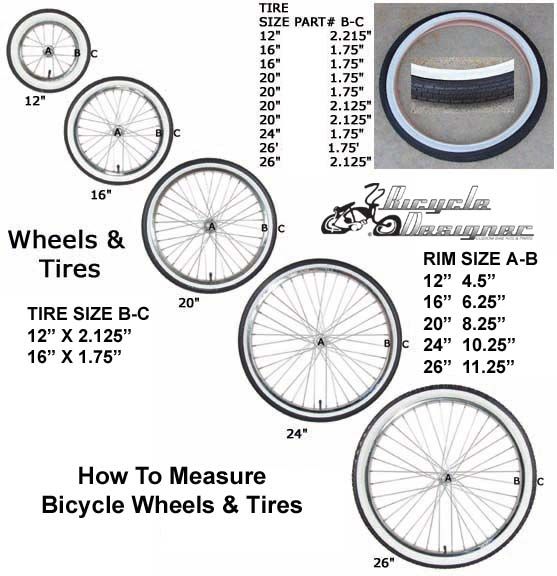 5 5 | 40-305 | Children's bicycles, folding, touring and some ligerades. | |
| 16 x 1.75 | 47-305 | |||
| 16 x 1.95 | 50-305 | |||
| 16 x 2.0 | 54-305 | |||
| 16 x 2.125 | 57-305 | |||
| 16 x 2.5 | 62-305 | |||
| 298 | 14 x 1 1/4 | 350-32A | 32-298 | Carriages, children's bikes, balance bikes |
| 288 | 14 x 1 3/8 | 350A, 350-35A | 37-288 | Children's bicycles, balance bikes |
| 14 x 1 5/8 | 350-38A | 40-288 | ||
| 14 x 1 5/8 x 1 3/8 | 350-42A | 44-288 | ||
| 14 x 1.75 | 47-288 | |||
| 279 | 14 x 1 1/2 | 350-38B | 40-279 | Children's bicycles, balance bikes |
| 254 | 14 x 1. 5 5 | 40-254 | Children's bicycles, balance bikes | |
| 14 x 1.75 | 47-254 | |||
| 14 x 2 | 54-254 | |||
| 239 | 12 1/2 x 1 3/8 x 1 1/4 | 300-32A 300x32A | 32-239 | Children's bicycles, balance bikes |
| 205 | 12 1/2 x 2 1/4 | 56-205 | Children's bicycles "KVD", balance bikes, sometimes suitable for baby carriages ("Dutik" tires) | |
| 203 | 12 x 1.75 12 1/2 x 1.75 12 1/2 x 1.9 | 47-203 | Small children's bicycles, balance bikes, baby carriages | |
| 12 x 1.95 | 54-203 | |||
| 12 x 2.0 | 50-203 | |||
| 12 x 2.125, 12 1/2 x 2 1/4 R | 57-203 | |||
| 12 1/2 x 2 1/4 | 62-203 | |||
| 176 | 55-176 | Tires for tricycles, scooters, balance bikes for small children, wheelbarrows and carts, prams | ||
| 152 | 10 x 2 | 54-152 | ||
| 137 | 8 x 1 1/4 | 32-137 |
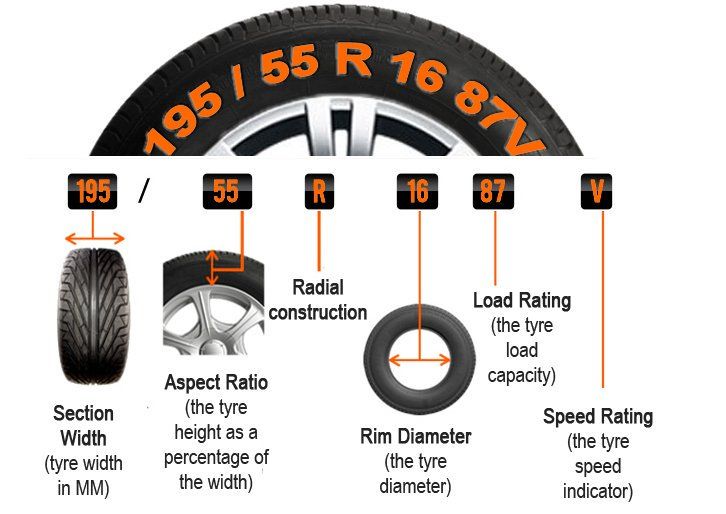 29 tires differ from 28 only in height.
29 tires differ from 28 only in height. Tire width selection is more flexible than rim diameter.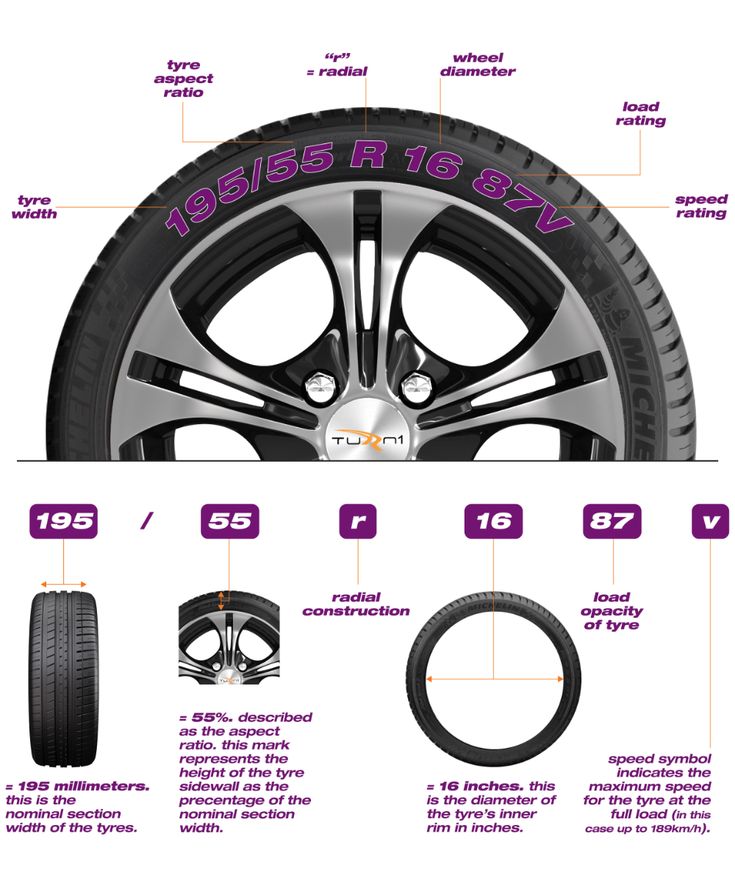
Rim widths are measured and marked in millimeters as shown in the figure at the beginning of the article.
How to measure the width of the rim is described in a separate article here.
| Rim width in mm | Tire width in mm and inches | Bicycle type |
| 13 | 18 - 25 mm (1") | road and cyclocross models |
| 15 | 23 - 32 mm (1" - 1.25") | |
| 17 | 25-37 mm (1" - 1.5") | light cross-country and hybrid models |
| 18 | 28 - 44 mm (1.1" - 1.75") | Heavy XC/Hybrid |
| 19 | 28 - 60 mm (1.1" - 2.35") | MTB (mountain bikes, mountain bikes) |
| 20 | 28 -47 mm (1.1" - 2") | cycling and light extreme |
| 21 | 35 - 50 mm (1. 4" - 2") 4" - 2") | |
| 23 | 40 - 50 mm (1.5" - 2.1") | extreme cycling |
| 25 or more | 44 - 57 mm (1.75" - 2.25") | |
| 32 | 75 mm (3") and over |
This table is a guideline for an average bike. Use it not as a dogma, but as a guideline for selection.
Some manufacturers give their own tables for the tires they produce, according to which they need to be selected for their wheel.

The width of the tire affects rolling and traction. The wider - the better the grip, cornering control, but the worse the roll.
It is considered optimal if the width of the tire is 1.5-2.1 times wider than the inner width of the rim. It is possible and 2.5 times, but this is already an amateur.
The tire-to-rim width ratio affects the tire's cornering behavior. Too wide tires mounted on a narrow rim can simply break. will have a pear-shaped profile.
Further, if toothy rubber is installed on the wheel, then the side spikes on the tread will not be where they should be for confident grip in the turn.
With wide tires on a narrow rim, the side studs will be too high and will not hold properly in the turn.
On narrow tires with a wide rim, the spikes will be from below and with a good slope, the bike will ride on the sidewall, and she is bald.
Below is the famous table compiled by Georg Boeder of tire and rim width recommendations
fractional inches) here.